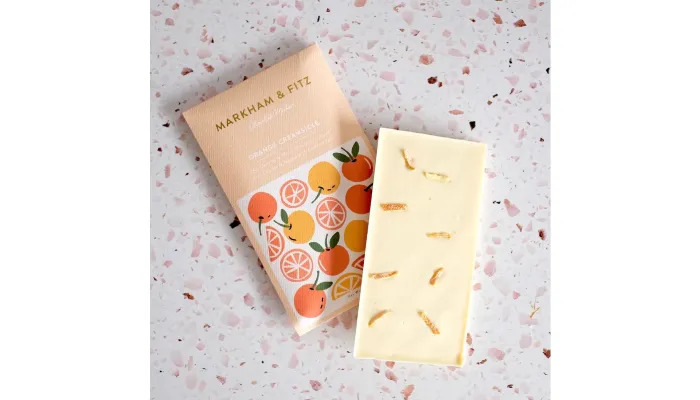Making a white chocolate bar at home is pretty straightforward if you have the right ingredients and tools. Start with cocoa butter, whole milk powder, and sugar, grind the sugar and milk powder into a fine powder to avoid graininess in your chocolate. Melt the cocoa butter gently using a double boiler or microwave, then slowly mix in the powdered ingredients while stirring constantly. For a smoother texture, blend the mixture with a food processor or blender for several minutes, though homemade bars may still be slightly grainy without specialized equipment like a melanger. Pour into molds, chill until solid, then enjoy or store in an airtight container at room temperature or refrigerated for longer freshness.
Basic Ingredients for Homemade White Chocolate
To make white chocolate at home, you’ll need a few key ingredients that work together to create its creamy, sweet flavor. The main fat component is cocoa butter, about ½ cup (roughly 3 ounces), which should be food-grade and free from any additives or preservatives to ensure purity and the best texture. Whole milk powder, also around ½ cup (3 ounces), adds richness and a smooth dairy flavor; choosing whole milk powder over nonfat is important because it makes the chocolate creamier and more authentic in taste. For sweetness, use ½ cup (about 1.5 ounces) of powdered sugar or finely ground granulated sugar, powdered sugar without cornstarch is ideal to avoid any impact on texture, but if you only have granulated sugar, grinding it finely works well too. You can adjust the sugar amount slightly to suit your personal sweetness preference. Adding a small amount of vanilla extract, about ¼ teaspoon, can enhance the overall flavor profile and bring out the subtle notes in the chocolate. While lecithin is sometimes used as an emulsifier to improve texture and consistency, it’s optional and not necessary for homemade batches. Remember, white chocolate contains no cocoa solids, only cocoa butter, milk powder, and sugar, so avoid adding any cocoa powder or other chocolate ingredients. This simple combination of quality ingredients is the foundation for crafting a smooth, rich white chocolate bar right in your own kitchen.
Tools and Equipment Needed
To make a white chocolate bar at home, having the right tools makes the process smoother and the final product better. Start with a food processor or a high-speed blender to grind and blend your dry ingredients like sugar and milk powder into a fine powder. If you don’t have one, a spice grinder or mortar and pestle can work well for this step. For melting cocoa butter, a double boiler setup is ideal: place a heat-safe bowl over a pot of simmering water to gently melt without burning. Alternatively, you can use a microwave-safe bowl and melt the cocoa butter in short 30-second bursts, stirring often to avoid overheating. Silicone or candy bar molds are essential for shaping your chocolate bars neatly and making them easy to remove once set. A spatula comes in handy for stirring and scraping the mixture while melting and mixing ingredients. If you want an ultra-smooth texture, a chocolate melanger is a great tool, though optional and usually for more dedicated home chocolatiers. Using a thermometer can help you keep track of the cocoa butter’s temperature for precise melting, but it’s not strictly necessary. Once your bars are molded, you’ll need a clean, dry container to store them and enough fridge or freezer space to allow the chocolate to set properly. Having these basic tools ready sets the stage for a better homemade white chocolate experience.
- A food processor or high-speed blender to grind and blend dry ingredients smoothly.
- Spice grinder or mortar and pestle as alternatives for grinding sugar and milk powder.
- Double boiler setup: a pot with simmering water and a heat-safe bowl to gently melt cocoa butter.
- Microwave-safe bowl if using microwave method for melting cocoa butter in short bursts.
- Silicone or candy bar molds to shape the white chocolate bars.
- Spatula for stirring and scraping the mixture during melting and mixing.
- Optional chocolate melanger for achieving an ultra-smooth and creamy texture.
- Thermometer to monitor temperature during melting if precision is desired.
- A clean, dry container for storing the finished white chocolate bars.
- Refrigerator or freezer space to set and store the molded chocolate bars.
How to Grind Sugar and Milk Powder?
To achieve a smooth texture in your homemade white chocolate, start by combining whole milk powder and sugar before grinding. This helps create an even blend and prevents grainy spots in the final product. Using a food processor or a spice grinder, pulse the mixture intermittently until it reaches a very fine, powdery consistency similar to confectioners’ sugar but without the added cornstarch. If you only have granulated sugar, grinding it together with the milk powder is essential to avoid coarse particles that could affect the chocolate’s mouthfeel. Be careful not to add any moisture during grinding, as this can cause clumping. Pulsing the grinder rather than running it continuously also helps prevent heat buildup and sticking. After grinding, if possible, sift the mixture to remove any remaining larger particles for the best texture. If you’re not using the ground ingredients immediately, store them in an airtight container to keep them dry and fresh. For the smoothest results, grind fresh before each batch of chocolate.
Melting Cocoa Butter Safely
To melt cocoa butter properly, start by breaking it into small chunks or discs; this helps it melt more evenly and quickly. The safest way is using a double boiler: place a heat-proof bowl over a pot of simmering water, making sure the bowl doesn’t touch the water. Stir the cocoa butter gently while it melts to spread the heat evenly and avoid hot spots. Direct heat can easily burn or overheat cocoa butter, so patience is key. If you prefer the microwave, use 30-second intervals, stirring between each to prevent overheating and uneven melting. Keep the temperature below 120°F (49°C) to maintain the cocoa butter’s quality and flavor. Once fully melted, remove it from heat immediately to stop separation. Also, use clean, dry utensils only, any water can cause the chocolate to seize, ruining the texture. After melting, work quickly to mix in other ingredients before the cocoa butter solidifies again.
Mixing Ingredients Thoroughly
Begin by gradually adding the finely ground sugar and milk powder into the melted cocoa butter. Stir continuously to combine the dry ingredients with the fat evenly. At first, the mixture might look crumbly or uneven, but keep stirring, this is normal until everything fully blends. Use a spatula to scrape the sides of the bowl regularly, making sure no dry pockets remain. Avoid adding any liquids here, as they can cause the mixture to separate or change texture. If you’re using vanilla extract for flavor, mix it in at this stage to distribute it evenly. The key is to achieve a smooth, consistent blend without lumps. Keep the mixture warm enough to stay liquid but not so hot that it overheats; if it thickens too much, gently reheat before moving on. Have your molds and utensils ready to pour the mixture immediately after mixing, so the texture stays just right for shaping.
Blending for a Smooth Texture
After combining your melted cocoa butter with the finely ground sugar and milk powder, transfer the mixture into a food processor or blender to improve its texture. Depending on your equipment and the smoothness you want, blend anywhere from 15 seconds up to 5 minutes. Longer blending helps reduce graininess and creates a more even, homogenous texture. Be sure to stop occasionally and scrape down the sides to make sure all ingredients are evenly incorporated. Keep the mixture warm during blending so the cocoa butter stays liquid, which aids in achieving a smooth consistency. Avoid over-blending, as this can introduce unwanted air bubbles that affect the final texture. If you have access to a chocolate melanger, follow the manufacturer’s instructions for the best results, as it is designed to refine texture more effectively than standard kitchen appliances. Once blended, check the consistency and, if needed, briefly reheat the mixture to keep it pourable before molding. Working efficiently here is key to prevent the chocolate from cooling and thickening prematurely, which can make pouring difficult and affect the final bar’s smoothness. Even with careful blending, some slight graininess may remain without commercial equipment, but this step significantly improves the overall texture of your homemade white chocolate.
Pouring and Setting the Chocolate
Once your white chocolate mixture is smooth and ready, carefully pour it into your prepared candy bar molds. If you want to add some texture, sprinkle mix-ins like nuts or dried fruit into the molds before pouring. After pouring, gently tap the molds on the countertop to help release any trapped air bubbles, which can cause holes or uneven spots in the bars. Use a spatula to level the surface, ensuring the chocolate has a uniform thickness. Place the molds on a flat surface inside the refrigerator for about 20 to 30 minutes to allow the chocolate to harden fully. Avoid freezing the bars, as rapid cooling can negatively affect the texture, causing it to become grainy or develop a dull finish. You can loosely cover the molds to prevent condensation from forming on the surface, which might leave white spots. Before unmolding, check that the chocolate is firm to avoid breaking your bars. Handle the molds gently when removing the chocolate to preserve their shape and smooth surface. Taking these steps will help you achieve clean, evenly set white chocolate bars at home.
Removing and Storing Your Chocolate Bars
Once your white chocolate bars have fully set, carefully invert the molds to release them. If the bars seem stuck, gently flex silicone molds or tap them lightly on the counter to loosen the chocolate without cracking it. After removal, inspect each bar for any imperfections or trapped air bubbles that may have formed during setting. To keep your bars fresh, store them at room temperature in a cool, dry place away from direct sunlight. Using airtight containers or resealable bags helps protect the chocolate from moisture and unwanted odors. The ideal storage temperature is below 70°F (21°C) but above refrigeration temperatures to avoid causing bloom, which appears as a whitish film on the surface. If your home is warmer than this, refrigerate the bars for up to two weeks. For longer storage, you can freeze the bars for up to three months by wrapping them tightly in plastic wrap and placing them in a freezer-safe container. When you’re ready to enjoy frozen chocolate, let the bars gradually come back to room temperature before unwrapping to prevent condensation. Label your storage containers with the date to keep track of freshness and ensure your homemade white chocolate bars stay delicious.
Tips and Variations to Enhance Flavor
To boost the flavor of your homemade white chocolate, adding vanilla extract in small increments of about ¼ teaspoon can really enhance its aroma and taste without overpowering the delicate cocoa butter base. For texture and extra taste, consider folding in finely chopped nuts, cereals, or dried fruits just before pouring the mixture into molds. If you want a smoother, less grainy bar, using a chocolate melanger is highly effective, it refines the mixture much better than a standard blender. A pinch of salt can also help balance the sweetness and bring out deeper flavor notes. Don’t hesitate to experiment with natural flavorings like citrus zest or almond extract to create unique twists. To achieve a creamier texture, slightly increase the amount of whole milk powder, but be mindful this can affect firmness. If you prefer your chocolate less sweet, simply reduce the sugar, adjusting gradually to your taste. While tempering white chocolate isn’t required, doing so can give your bars a nicer shine and a satisfying snap. Using organic or high-quality ingredients makes a noticeable difference in flavor authenticity. One crucial tip: avoid any water contact during the process, as even a small amount can cause the chocolate to seize and ruin the texture.
Creative Ways to Use White Chocolate
White chocolate bars are a delicious treat on their own, but you can take them further by melting the chocolate to create tasty dips for pretzels, fresh fruit, or even popcorn. Drizzling melted white chocolate over cakes, cookies, or ice cream adds a smooth, sweet touch that enhances your desserts. You can also mix chunks or chips of white chocolate into cookie or brownie batter for little bursts of creamy sweetness throughout. Another fun idea is to make white chocolate bark by combining melted chocolate with nuts and dried fruits, then letting it set into a crunchy, flavorful snack. For richer desserts, melted white chocolate works well in ganache or frosting, giving cakes and cupcakes a smooth, velvety finish. If you want to get a bit fancy, homemade white chocolate truffles are easy to make by mixing melted chocolate with cream and your choice of flavorings. Combining white chocolate with dark or milk chocolate lets you craft layered or marbled bars that look as good as they taste. You can also use white chocolate to make cozy drinks like white chocolate mocha or flavored milk. Finally, homemade white chocolate bars wrapped in pretty packaging make thoughtful gifts that show you put in effort and care.

Mary Burns is a dedicated writer focusing on health and fitness topics. With a passion for promoting wellness and vitality, Mary shares her knowledge and expertise through engaging and informative blog posts.




